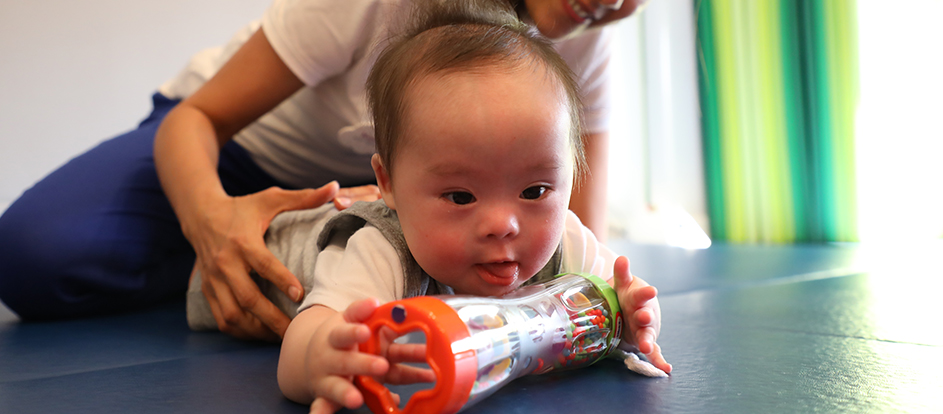

Supporting New Beginnings: The Neonatal and Pediatric Physical Therapist’s Role

Sujata Noronha
Senior Pediatric Physical Therapist
DHA License Number: 21863269-001

The journey to motherhood is a beautiful voyage filled with hope, expectations, and eager anticipation, as all parents eagerly await the arrival of their bundle of joy. In some cases, this journey may take an unexpected turn as their baby arrives prematurely, and they embark on a unique path, demonstrating remarkable resilience in the face of unexpected challenges.
In June 2023, the World Health Organization reported that in 2020, an estimated 13.4 million babies were born prematurely worldwide, translating to approximately 1 in 10 infants requiring Neonatal Intensive Care Unit (NICU) care due to their early arrival, before completing a full 37 weeks of gestation. This blog aims to bring attention to this critical issue and shed light on the crucial role that Physical Therapy (PT) plays in early intervention, starting right in the NICU.
Understanding the significance of early experiences on brain development is vital. From the moment of conception, the brain is rapidly growing and evolving. Preterm infants encounter altered sensory experiences and behavioral responses, which differ from the utero environment. They often experience painful stimuli, handling, and movement, and their muscle tone may not be adequately developed to counteract the force of gravity. These factors combined can put stress on their developing systems (Grunau 2013).
The developmental journey of preterm infants follows a distinct trajectory from full-term infants. Delays in one area of development, whether it’s motor skills, cognitive or social emotional, can have a cascading effect on others. The interconnectedness of all these domains emphasizes the importance of early assessment and intervention.
The well-being and development of preterm babies in the Neonatal Intensive Care Unit (NICU) involves a collaborative effort from various members of the medical care team and therapists. Each of these professionals plays a vital role in ensuring the best possible outcomes for these fragile infants. The combined efforts of this interdisciplinary team are vital for providing comprehensive and holistic care to preterm babies and to contribute to the well-being, growth, and developmental progress of these vulnerable infants during their time in the NICU and beyond (Pineda R. 2017).
What does a Physical Therapist do in the NICU?
The role of the physical therapist in the NICU is multifaceted and includes the 3 pillars of developmental care (Craig JW. 2020).
Neuroprotection:
The NICU is a challenging environment where a preterm infant from the dark safe cocoon of the mother’s womb is thrust into an environment filled with harsh light, sounds from medical equipment, and necessary but painful procedures. While these factors are essential for the infant’s survival, they can undoubtedly influence the development of the delicate and rapidly evolving brain.
Neuroprotection is a comprehensive and holistic approach aimed at safeguarding the fragile developing nervous system of preterm and critically ill neonates.
- The physical therapist will adapt strategies to mitigate the stress of this transition to the outside environment by dimming the lights, speaking in hushed tones, offering physical support with positioning pillows, and facilitating proper posture and movement for the infant.
- Minimizing exposure to stressful and painful experiences by implementing non-pharmacological pain management and positioning strategies like hand to midline and mouth, sucking, swaddle care to mitigate the adverse effects of stress and pain on the developing brain.
Neurodevelopment:
Within the womb, the infant receives constant sensory input through the surrounding uterine walls and amniotic fluid with zero effect of gravitational forces. As the fetus moves within this environment, each movement gently connects with the uterine wall, providing essential sensory input that aids in the development of muscles and tone (Altimer L 2016).
An infant born preterm goes suddenly from a zero gravity to an environment without boundary and has gravity. The muscular system and tone of the infant is not developed to counteract the effects of gravity and these preterm infants due to their low tone and extensor pattern are at a risk of thermal dysregulation, muscular imbalance, poor feeding skills and positional deformities like plagiocephaly and torticollis.
The neonatal physical therapist, in collaboration with other team members, will work on positioning to promote midline and flexion, protect sleep and prevent loss of energy through excessive movements, promote position to enable safe feeding and prevent positional deformities.
The physical therapist will constantly monitor the tone and movement pattern using various assessment scales specifically designed for preterm infants to keep a watch on their neuromuscular development and recommend exercises and positions to facilitate optimal development.
Nurturing infant family relationship:
The journey of the expecting patterns takes a different turn from what they expected when their child requires admission in the NICU. It leads to feeling of despair, fear and stress causing disruption of the normal process of maternal bonding and interaction.
The physical therapist in the NICU offers emotional support and reassurance to parents during the challenging experience by educating them about the infant’s condition, their behavior cues to watch for, techniques and strategies to support their infant’s development, such as positioning and handling, encouraging them to actively participate in safe daily care routines and kangaroo care (skin-to-skin contact).
By focusing on neuroprotection, neurodevelopment, and nurturing infant-family relationships, physical therapists in the NICU contribute significantly to the well-being and long-term outcomes of preterm infants.
Bridging the Gaps beyond the NICU
The role of a physical therapist is important not just in the NICU but also later to ensure continuity of care and close monitoring at regular intervals to track the progress of the neurodevelopment and provide Individualized Early Intervention support tailored to the child’s evolving developmental requirements.
Physical therapists play a crucial role in bridging the gap from NICU care to follow-up care post-discharge by providing parent education on the infant’s unique needs and how to support their development at home with pointers for proper positioning and handling techniques to ensure that the baby’s muscles and joints develop optimally and to reduce the risk of conditions like torticollis or positional plagiocephaly, strategies and exercises to improve feeding and swallowing and safe sleep positions.
The physical therapist will monitor the progress of premature infants and adjust their treatment plans as needed, helping to achieve developmental milestones and reduce long-term complications particularly for high-risk babies, such as those with extremely low birth weights or complex medical conditions, in ensuring they receive the necessary care and monitoring post-NICU discharge (Spittle A 2015).
Recognizing Early Developmental Concerns in Infants: A Guide for Parents
The journey to parenthood for parents with a newborn comes with its own set of challenges, including establishing feeding and sleep schedules. While each child is unique and follow their own development path, some general red flags to be aware of include: (Pathways.org)I
What are the red flags?
Although the following points are crucial for premature babies, they can also be a guideline for all new parents to track their child’s development.
- Lack of head control by 3 months
- Cannot tolerate tummy time
- Asymmetrical posture with preference to keep head on one side
- Unusual stiffness or floppiness in their body
- Noticeable differences in muscle tone or strength between one arm or leg and the other
- Limited Range of Motion in their limbs
- Persistent tight fist with fingers held closed
- Lack of eye contact or not paying attention to faces by the age of two to three months
- Failure to startle in response to loud noise
- Feeding difficulties that extend beyond what is typically considered normal
- Extended periods of crying and persistent challenges with soothing
- An unusually quiet and placid demeanor in the child
If any of these red flags are noticed, it is recommended that you consult your pediatrician who can assist in assessing whether a physical therapy evaluation may be warranted. Early intervention is often instrumental in addressing developmental concerns and enabling your infant to achieve their maximum potential.
CONCLUSION:
The collaboration between parents, healthcare providers, and physical therapists is essential to supporting fragile infants born preterm, as it helps foster a nurturing and growth-promoting environment. By addressing physical challenges early on, physical therapists not only enhance the quality of life for these children, but also provide families with the guidance and reassurance they need during what can be a challenging and uncertain time. Ultimately, the role of physical therapists in the NICU and early intervention after the discharge is an essential component in the journey towards a healthier and happier future for these remarkable young individuals.
At High Hopes, we acknowledge the pivotal role of Early Intervention and firmly believe that a pre-habilitative approach represents the path toward future development.
Kindly contact High Hopes for enquiries regarding our Early Intervention Development programme.
Sources:
- Als, H. (1982), Toward a synactive theory of development: Promise for the assessment and support of infant individuality. Infant Ment. Health J., 3: 229-243. https://doi.org/10.1002/1097-0355(198224)3:4<229::AID-IMHJ2280030405>3.0.CO;2-H
- DeMaster D, Bick J, Johnson U, Montroy JJ, Landry S, Duncan AF. Nurturing the preterm infant brain: leveraging neuroplasticity to improve neurobehavioral outcomes. Pediatr Res. 2019 Jan;85(2):166-175. doi: 10.1038/s41390-018-0203-9. Epub 2018 Oct 16. PMID: 30531968.
- Pickler RH, McGrath JM, Reyna BA, McCain N, Lewis M, Cone S, Wetzel P, Best A. A model of neurodevelopmental risk and protection for preterm infants. J Perinat Neonatal Nurs. 2010 Oct-Dec;24(4):356-65. doi: 10.1097/JPN.0b013e3181fb1e70. PMID: 21045616; PMCID: PMC3494740.
- Grunau RE. Neonatal pain in very preterm infants: long-term effects on brain, neurodevelopment and pain reactivity. Rambam Maimonides Med J. 2013 Oct 29;4(4):e0025. doi: 10.5041/RMMJ.10132. PMID: 24228168; PMCID: PMC3820298.
- Leslie Altimier, Raylene Phillips,:The Neonatal Integrative Developmental Care Model: Advanced Clinical Applications of the Seven Core Measures for Neuroprotective Family-centered Developmental Care,Newborn and Infant Nursing Reviews, Volume 16, Issue 4, 2016, Pages 230-244,
- Byrne E, Campbell SK. Physical therapy observation and assessment in the neonatal intensive care unit. Phys Occup Ther Pediatr. 2013 Feb;33(1):39-74. doi: 10.3109/01942638.2012.754827. PMID: 23311522.
- Khurana S, Kane AE, Brown SE, Tarver T, Dusing SC. Effect of neonatal therapy on the motor, cognitive, and behavioral development of infants born preterm: a systematic review. Dev Med Child Neurol. 2020 Jun;62(6):684-692. doi: 10.1111/dmcn.14485. Epub 2020 Feb 19. PMID: 32077096; PMCID: PMC7920849.
- Craig, J.W., Smith, C.R. Risk-adjusted/neuroprotective care services in the NICU: the elemental role of the neonatal therapist (OT, PT, SLP). J Perinatol 40, 549–559 (2020). https://doi.org/10.1038/s41372-020-0597-1
- Celeste M. Maguire, Jeanet Bruil, Jan M. Wit, Frans J. Walther,:Reading preterm infants’ behavioral cues: An intervention study with parents of premature infants born <32 weeks,Early Human Development,Volume 83, Issue 7,2007,Pages 419-424,
- Alicia Spittle, Karli Treyvaud,:The role of early developmental intervention to influence neurobehavioral outcomes of children born preterm,Seminars in Perinatology,Volume 40, Issue 8,2016,Pages 542-548,
- Pathways.org for Early Red Flags


